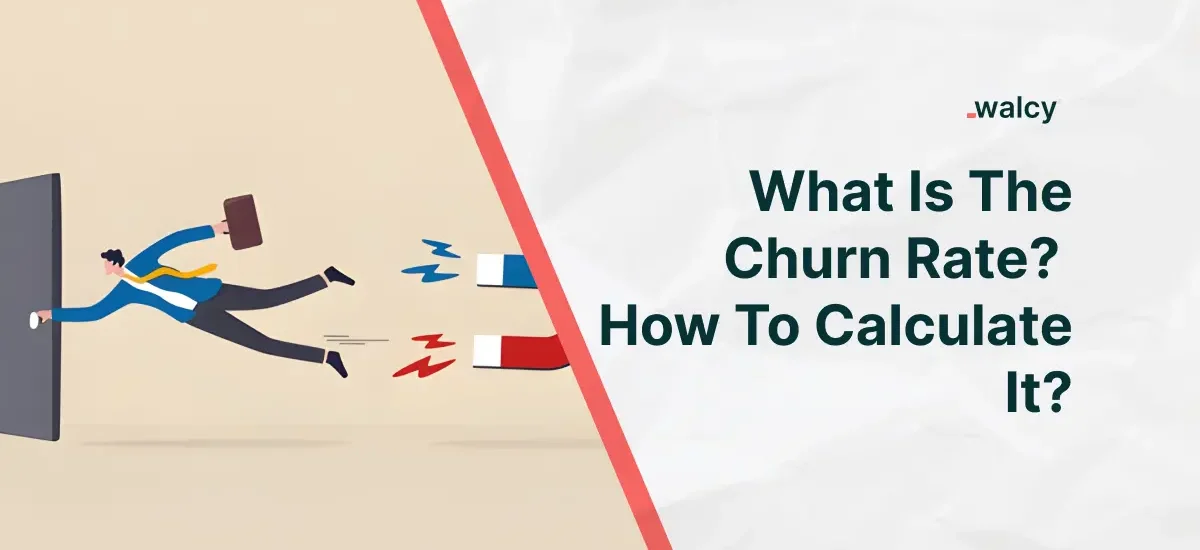Any business must realize that no customer or subscriber stays forever. The churn rate is a business indicator that analyses the number of subscribers or customers that eventually discontinue your company. Determining customer churn is essential for financial projections and loyalty/retention decision-making.
To gain long-term success for any business, it is crucial to understand customer behavior. The churn rate is one key metric that provides insight into this behavior. In the same way, retaining customers is of vital importance, and accomplishing this requires an extensive understanding of churn. This blog will delve deep into what churn rate is, why it matters, and how to calculate it effectively. Before everything else let’s know what the word “churn” means.
What Is The Churn rate?
The churn rate sometimes referred to as a company’s attrition rate, is the measure of customers that depart within a specific time frame. Assessing client retention and the general health of the firm depends heavily on this metric. More customers are leaving your firm when the churn percentage is higher. On the other hand, fewer customers are leaving while your churn rate is lesser.
It means that you will retain more customers than you do now. businesses with high turnover rates frequently confront issues like Increased client acquisition expenses and declining revenue.
Know about saving money during cross-border payments
What Does “Churn” Mean?
The word “churn” has several meanings depending on the context in which it is used. In business, churn refers to the rate at which customers stop doing business with a company within a given period. It is an important indicator for measuring client attrition, which has a substantial impact on a company’s revenue and growth.
To reduce churn, businesses should improve customer service, optimize the user experience, offer personalized solutions, and provide incentives for customer loyalty. Businesses can improve customer retention and drive long-term growth by understanding and proactively addressing the reasons behind customer churn.
Why Is Churn Rate Important?
There are several reasons why the churn rate is significant for businesses. Some of them are:
Profits Considerations:
A high churn rate is directly correlated with lost revenue. When customers depart, the company loses its immediate spending and incurs the price of attracting new customers to replace them.
Customer Acquisition Costs:
Retaining current customers is typically more economical than acquiring new ones. Companies that have to deal with churn run the danger of being caught in a never-ending cycle of investing in sales and marketing to bring in new customers.
Insights into Customer Satisfaction:
Understanding consumer happiness and product performance can be gained through churn analysis. Businesses may enhance their services and offers by knowing the reasons behind client attrition.
Long-term Growth:
A loyal customer base is key to sustainable growth. Reducing churn leads to higher customer lifetime value, which is crucial for long-term profitability.
How to Calculate Churn Rate?
Calculating the churn rate is straightforward and can be done using a simple formula. However, businesses may need to adapt their calculations based on their specific circumstances. Here is a basic formula for calculating it:
Basic Formula
Churn Rate = (Number of Customers Lost During Period / Total Number of Customers at Start of Period)×100
Example Calculation
Assume a business starts with 100 consumers at the beginning of the month and loses 5 by the end. The churn rate will be determined as follows:
The churn rate = (5/100)×100, which equals 5%.
Variations in Calculation
Although the fundamental formula is helpful, companies may need to take into account more complicated scenarios:
Monthly vs. Annual Churn Rate:
Churn can be calculated quarterly, annually, or monthly, depending on the company model. Monthly churn is frequently more significant for subscription-based businesses.
Segmented Churn Rate:
To obtain a more in-depth understanding, businesses can also compute churn rates for particular segments, such as by product line or customer demographics.
Gross vs. Net Churn Rate:
The gross rate solely takes into account lost customers, while the net rate also takes into account new ones acquired in the same time frame. This offers a more impartial perspective on client retention.
Factors Influencing Churn Rate
Understanding the factors that influence churn can help businesses develop strategies to mitigate it. Here are some common reasons customers may choose to leave:
Poor Customer Service:
Negative experiences with customer support can lead to high churn. A study indicates that 50% of customers will stop doing business with a company after just one bad interaction.
Lack of Engagement:
Customers who feel neglected or unvalued are more likely to leave. Businesses should regularly conduct engagement activities.
Product Quality:
If a product does not satisfy customers’ expectations, they are most likely to look for alternatives. Businesses need to focus on continuous improvement and innovation.
Price Sensitivity:
Customers may leave if they find better value elsewhere. Regularly reviewing pricing strategies is crucial to retaining price-sensitive customers.
Market Competition:
Increased competition can lead to higher churn. Businesses must differentiate themselves to retain customers.
Strategies To Reduce Churn Rate
To effectively manage churn, businesses should implement proactive strategies aimed at retention. Here are a few approaches:
Enhance Customer Experience
It is one of the best methods to reduce the churn. Investing in customer service and support significantly reduces churn. Providing timely and effective assistance fosters loyalty and satisfaction.
Gather Customer Feedback
Regularly requesting feedback through surveys and evaluations assists firms in identifying pain spots and opportunities for development. Listening to customers can guide product enhancements and service improvements.
Implement Loyalty Programs
Another way of reducing the churn rate is to implement different types of loyalty programs. Creating loyalty programs that reward repeat customers encourages them to stay. These programs include discounts, exclusive offers, or points systems that incentivize continued patronage.
Identify Customers at Risk
Using data analytics to detect customers who are about to churn allows firms to act before they depart. This might include personalized outreach or focused marketing strategies.
Improve Onboarding Processes
For subscription-based services, ensuring a smooth onboarding process helps new customers see value quickly. Providing tutorials, guides, and support during the initial stages enhances customer satisfaction.
Review metrics regularly.
Monitoring churn, as well as other key performance metrics, assists firms in maintaining high customer retention. Regular evaluations can show patterns and help make strategic decisions.
What Are The Different Types Of Churn Rates?
Churn rates can be classified into several types. Some of them are:
Voluntary Churn
This sort of churn happens when a client voluntarily chooses to discontinue utilizing a product or service. Reasons for voluntary churn include unhappiness with the service, passing to a competitor, or limited finances. Understanding the reasons for voluntary churn is critical to enhancing client retention strategy.
Involuntary Churn
Involuntary churn happens when customers are lost due to circumstances beyond their control. Common causes include payment failures (like credit card declines), administrative errors, or accidental cancellations. This type of churn can often be mitigated through better payment processing and customer communication.
Revenue Churn
Revenue churn analyzes the revenue lost as a result of customer reductions or cancellations. It focuses on the financial side of churn. Losing a high-value client can have a greater impact on revenue than losing a larger number of lower-value customers. That is why understanding this metric is essential.
Net Churn
Net churn refers to the proportion of revenue lost from current customers over time. It provides a more comprehensive view of a company’s growth or decline by considering both losses and gains within the customer base.
Conclusion
One important indicator of customer loyalty and the overall condition of the company is the churn rate. Businesses apply various efficient tactics to lower churn and promote enduring connections with their clients by knowing how to measure it and the factors impacting it.
Keeping existing consumers is just as important as gaining new ones in an increasingly competitive industry. In addition to reducing turnover, companies may eventually boost growth and profitability by concentrating on customer involvement and pleasure.
Gaining a strong foundation for future success is the goal of understanding and managing churn, instead of just avoiding losses.
Know everything about expanding business globally
FAQs
What does churn mean in marketing?
In marketing, churn is the rate at which consumers discontinue interacting with a firm after a certain amount of time. This may happen in the form of paying users canceling or consumers unsubscribing from a marketing campaign or channel.
What is the churn in sales?
In sales, the Churn rate is the rate at which the customers stop using or purchasing products or services. Also, it includes the rate of customers quitting the product.
What is a good churn rate?
The optimal churn rate for established and profitable companies is 5% to 7% annually and less than 1% monthly. If your SaaS firm had 5,000 clients, you would lose just 25 each year, or two to three every month.
Which industry has the highest churn rate?
Churn rates are the highest in the e-commerce industry. It is estimated to be between 70% – 80%.
What is the average churn rate of the SAAS industry?
The average churn rates of the SAAS industry is around 5% – 7% annually
Do follow us on Facebook and Linkedin, to stay connected with us.



